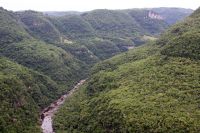The coastal region of Brazil, specifically the southeast portion of it, is home to both of the country’s most populous cities in Rio de Janeiro and São Paulo (their combined population being around 18 million). Points further north along the coastline do not lag too far behind, either, with Salvador, Fortaleza and others contributing to the situation whereby 81% of the Brazilian population is urban.
Depending on your personal energy levels, the promise of non-stop baile funk parties and wild cultural fusion held out by coastal locales like Rio is not always a fair trade-off for peace of mind. Fans of Sebastião Salgado’s documentary photography or Jose Padilho’s Elite Squad films, while certainly not possessing any insider knowledge about Brazilian city life, are already familiar with the problems that can haunt these cities: the former’s stark depictions of urban poverty, and the latter’s dark portrayal of a cops-and-robbers urban landscape in which it’s difficult to tell who the “good guys” are, have relegated the coastal mega-cities to “nice place to visit, but…” status for many.Though some scholars have noted a “relative lack of conflict between [Rio’s] deprived hillside communities and the affluent neighborhoods on the streets just below them”, many just find the cities too congested and too haphazardly assembled to live in comfortably. For these people, there are definitely alternatives further inland.
Brasília: Brazil's 'planned city'
One of the more singular and visually striking inland locations is the capital city of Brasília, the location of all three branches of Brazil’s federal government and the showcase of modernist architecture in the vein of Le Corbusier (his plans in The Radiant City and The City for 3 Million provide the germ for Brasilia’s layout). The brainchild of architect Oscar Niemeyer and urban planner Luisa Costa, whose plan was chosen by an international jury over many other worthy entries, some of the city’s architectural features are immediately recognizable. The unique volcanic appearance of the Cathedral of Brasília is just one of these landmarks. The city’s centrality to government affairs means that expatriates working as diplomats, or as political representatives of any stripe, may want to consider moving here in order to cut down on travel time.
Still, Brasília may not be the exact compromise that many are looking for. Its sharp break from visual traditions has been accompanied by a break with social traditions: its lack of street life makes it, in some ways, the polar opposite of Rio, and its being the physical embodiment of Brazil’s “Order and Progress” motto also means it is a very no-nonsense, businesslike living environment.
Manaus: the urban Amazon
The northern city of Manaus, in the state of Amazonas, is another highly populous area, though its urban sprawl is not exactly comparable to what the southeastern coastal cities experience. The green space within Manaus proper, in comparison with São Paulo and Rio, also gives it another significant advantage over those cities (the forest near the Federal University of Amazonas is actually the largest urban forest in the world). Along these lines, it remains a popular destination for the “eco-tourist” community within and throughout Brazil, due to its proximity to the rain forest.
Even with a guaranteed trade in local tourism, the city is not the linchpin of the national economy – nevertheless, it promises tax incentives to businesses hoping to set up shop there (see especially the Free Economic Zone of Manaus) and hosts communications-oriented tech firms like Nokia and Siemens. Homegrown industries like the automotive company Amazon Veiculos, as well as two airlines, are centered here – overall, it seems like enough local industry exists to provide some opportunities for consultants, quality management experts and likeminded jobs (especially among those who can claim some Portuguese fluency).
Leisure time possibilities in the city are manifold, with everything from sports parks to opera houses dotting the Manaus landscape. Though there are not as many miles of beach here as in that other Brazilian city we’ve mentioned enough times already, the city’s riverside location allows for boating and for other aquatic activities. Here you can also see a true oddity of nature: the muddy brown waters of the Rio Solimões and the clearer water of the Rio Negro, which run up against each other without mixing.
Teresina
Going yet further down the list of cities by population, the city of Teresina, in Piauí state, represents an opportunity to be close to the northeastern coast without being directly on it. The considerable number of universities in this city makes it a good choice for both educational professionals with fluency in English, Portuguese or Spanish (or any combination thereof). There is also a fairly strong export industry and local manufacturing base here for textiles, pharmaceuticals and more. Despite its being a mid-sized city by Brazilian standards, it has a nine-station metro rail system to take pressure off of the city’s bus traffic. Just be prepared to receive more than your fair share of hot weather: meteorological surveys place this city at the top of the list for cities experiencing hot temperatures.

